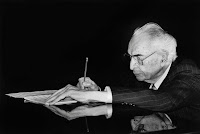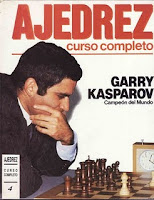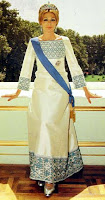His long-time musical partner, alto saxophonist Paul Desmond, wrote the Dave Brubeck Quartet's best remembered piece, "Take Five",which is in 5/4 time and has endured as a jazz classic on the top-selling jazz album, Time Out. Brubeck experimented with time signatures throughout his career, recording "Pick Up Sticks" in 6/4, "Unsquare Dance" in 7/4, and "Blue Rondo à la Turk" in 9/8. He is also a respected composer of orchestral and sacred music, and wrote soundtracks for television such as Mr. Broadway and the animated mini-series This Is America, Charlie Brown.
 Brubeck was born in Concord, California and grew up in Ione. He is of English (maternal) and Swiss (paternal) ancestry His father, Howard "Pete" Brubeck, was a cattle rancher, and his mother, Elizabeth (née Ivey), who had studied piano in England under Myra Hess and intended to become a concert pianist, taught piano for extra money. Brubeck originally did not intend to become a musician (his two older brothers, Henry and Howard, were already on that track), but took lessons from his mother. He could not read sheet music during these early lessons, attributing this difficulty to poor eyesight, but "faked" his way through, well enough that this deficiency went mostly unnoticed.
Brubeck was born in Concord, California and grew up in Ione. He is of English (maternal) and Swiss (paternal) ancestry His father, Howard "Pete" Brubeck, was a cattle rancher, and his mother, Elizabeth (née Ivey), who had studied piano in England under Myra Hess and intended to become a concert pianist, taught piano for extra money. Brubeck originally did not intend to become a musician (his two older brothers, Henry and Howard, were already on that track), but took lessons from his mother. He could not read sheet music during these early lessons, attributing this difficulty to poor eyesight, but "faked" his way through, well enough that this deficiency went mostly unnoticed. Intending to work with his father on their ranch, Brubeck entered the College of the Pacific (now the University of the Pacific) studying veterinary science, but transferred on the urging of the head of zoology, Dr Arnold, who told him "Brubeck, your mind's not here. It's across the lawn in the conservatory. Please go there. Stop wasting my time and yours." Later, Brubeck was nearly expelled when one of his professors discovered that he could not read music. Several of his professors came forward, arguing that his ability with counterpoint and harmony more than compensated. The college was still afraid that it would cause a scandal, and agreed to let Brubeck graduate only after he promised never to teach piano.
Intending to work with his father on their ranch, Brubeck entered the College of the Pacific (now the University of the Pacific) studying veterinary science, but transferred on the urging of the head of zoology, Dr Arnold, who told him "Brubeck, your mind's not here. It's across the lawn in the conservatory. Please go there. Stop wasting my time and yours." Later, Brubeck was nearly expelled when one of his professors discovered that he could not read music. Several of his professors came forward, arguing that his ability with counterpoint and harmony more than compensated. The college was still afraid that it would cause a scandal, and agreed to let Brubeck graduate only after he promised never to teach piano. After graduating in 1942, Brubeck was drafted into the army and served overseas in George Patton's Third Army. He was spared from service in the Battle of the Bulge when he volunteered to play piano at a Red Cross show; he was such a hit he was ordered to form a band. Thus he created one of the U.S. armed forces' first racially integrated bands, "The Wolfpack". While serving, Brubeck met Paul Desmond in early 1944. He returned to college after serving nearly four years in the army, this time attending Mills College and studying under Darius Milhaud, who encouraged him to study fugue and orchestration, but not classical piano. While on active duty, he received two lessons from Arnold Schoenberg at UCLA in an attempt to connect with High Modernism theory and practice. However, the encounter did not end on good terms since Schoenberg believed that every note should be accounted for, an approach which Brubeck could not accept.
After graduating in 1942, Brubeck was drafted into the army and served overseas in George Patton's Third Army. He was spared from service in the Battle of the Bulge when he volunteered to play piano at a Red Cross show; he was such a hit he was ordered to form a band. Thus he created one of the U.S. armed forces' first racially integrated bands, "The Wolfpack". While serving, Brubeck met Paul Desmond in early 1944. He returned to college after serving nearly four years in the army, this time attending Mills College and studying under Darius Milhaud, who encouraged him to study fugue and orchestration, but not classical piano. While on active duty, he received two lessons from Arnold Schoenberg at UCLA in an attempt to connect with High Modernism theory and practice. However, the encounter did not end on good terms since Schoenberg believed that every note should be accounted for, an approach which Brubeck could not accept. After completing his studies under Milhaud, Brubeck helped to establish Berkeley, California's Fantasy Records. He worked with an octet (the recording bears his name only because Brubeck was the best-known member at the time), and a trio including Cal Tjader and Ron Crotty. Highly experimental, the group made few recordings and got even fewer paying jobs. The trio was often joined by Paul Desmond on the bandstand, at Desmond's prodding.
After completing his studies under Milhaud, Brubeck helped to establish Berkeley, California's Fantasy Records. He worked with an octet (the recording bears his name only because Brubeck was the best-known member at the time), and a trio including Cal Tjader and Ron Crotty. Highly experimental, the group made few recordings and got even fewer paying jobs. The trio was often joined by Paul Desmond on the bandstand, at Desmond's prodding.Following a near-fatal swimming accident which incapacitated him for several months, Brubeck organized The Dave Brubeck Quartet in 1951, with Desmond on saxophone. They took up a long residency at San Francisco's Black Hawk nightclub and gained great popularity touring college campuses, recording a series of albums with such titles as Jazz at Oberlin (1953), Jazz at College of the Pacific (1953), and Brubeck's debut on Columbia Records, Jazz Goes to College (1954). In that same year, he was featured on the cover of Time magazine, the second jazz musician to be so honored (the first was Louis Armstrong on February 21, 1949.
Early bassists for the group included Ron Crotty, Bob Bates, and Bob's brother Norman Bates; Lloyd Davis and Joe Dodge held the drum chair. In 1956, Brubeck hired Joe Morello, who had been working with Marian McPartland; Morello's presence made possible the rhythmic experiments that were to come. In 1958 Eugene Wright joined for the group's U.S. State Department tour of Europe and Asia; Wright would become a permanent member in 1959, making the "classic" Quartet's personnel complete.
 Wright is African-American; in the late 1950s and early 1960s Brubeck canceled several concerts because the club owners or hall managers resisted the idea of an integrated band on their stages. He also canceled a television appearance when he found out that the producers intended to keep Wright off-camera.
Wright is African-American; in the late 1950s and early 1960s Brubeck canceled several concerts because the club owners or hall managers resisted the idea of an integrated band on their stages. He also canceled a television appearance when he found out that the producers intended to keep Wright off-camera.In 1959, the Dave Brubeck Quartet recorded Time Out, an album their label was enthusiastic about but nonetheless hesitant to release. Featuring the album art of S. Neil Fujita, the album contained all original compositions, almost none of which were in common time: 9/8, 5/4, 3/4, and 6/4 were used. Nonetheless, on the strength of these unusual time signatures (the album included "Take Five", "Blue Rondo à la Turk", and "Three To Get Ready"), it quickly went platinum.
Time Out was followed by several albums with a similar approach, including Time Further Out: Miro Reflections (1961), using more 5/4, 6/4, and 9/8, plus the first attempt at 7/4; Countdown: Time in Outer Space (dedicated to John Glenn) (1962), featuring 11/4 and more 7/4; and Time Changes (1963), with much 3/4, 10/4 (which was really 5+5), and 13/4. These albums were also known for using contemporary paintings as cover art, featuring the work of Joan Miró on Time Further Out, Franz Kline on Time in Outer Space, and Sam Francis on Time Changes.
 A high point for the group was their 1963 live album At Carnegie Hall, described by critic Richard Palmer as "arguably Dave Brubeck's greatest concert".
A high point for the group was their 1963 live album At Carnegie Hall, described by critic Richard Palmer as "arguably Dave Brubeck's greatest concert".In the early '60s, Brubeck and his wife Iola developed a jazz musical, The Real Ambassadors, based in part on experiences they and their colleagues had during foreign tours on behalf of the U.S. State Department. The soundtrack album, which featured Louis Armstrong, Lambert, Hendricks & Ross, and Carmen McRae was recorded in 1961; the musical itself was performed at the 1962 Monterey Jazz Festival.
At their peak in the early '60s, the Brubeck Quartet was releasing as many as four albums a year. Apart from the 'College' and the 'Time' series, Brubeck recorded four LPs featuring his compositions based on the group's travels, and the local music they encountered. Jazz Impressions of the USA (1956, Morello's debut with the group), Jazz Impressions of Eurasia (1958), Jazz Impressions of Japan (1964), and Jazz Impressions of New York (1964) are less well-known albums, but all are brilliant examples of the quartet's studio work, and they produced Brubeck standards such as "Summer Song," "Brandenburg Gate," "Koto Song," and "Theme From Mr. Broadway." (Brubeck wrote, and the Quartet performed, the theme song for the Craig Stevens CBS drama series; the music from the series became material for the "New York" album.)
 In 1961 Dave Brubeck appeared in a few scenes of the British Jazz/Beat film All Night Long, which starred Patrick McGoohan and Richard Attenborough. Brubeck merely plays himself, and his piano playing includes closeups of his fingerings. Brubeck performs "It's a Raggy Waltz" from the Time Further Out album and duets briefly with bassist Charles Mingus in "Non-Sectarian Blues".
In 1961 Dave Brubeck appeared in a few scenes of the British Jazz/Beat film All Night Long, which starred Patrick McGoohan and Richard Attenborough. Brubeck merely plays himself, and his piano playing includes closeups of his fingerings. Brubeck performs "It's a Raggy Waltz" from the Time Further Out album and duets briefly with bassist Charles Mingus in "Non-Sectarian Blues".In the early 1960s Dave Brubeck was the program director of WJZZ-FM radio (now WEZN). He achieved his vision of an all jazz format radio station along with his friend and neighbor John E. Metts, one of the first African Americans in senior radio management.
The final studio album for Columbia by the Desmond/Wright/Morello quartet was Anything Goes (1966) featuring Cole Porter songs. A few concert recordings followed, and The Last Time We Saw Paris (1967) was the "Classic" Quartet's swansong.
Brubeck's disbanding of the Quartet at the end of 1967 allowed him more time to compose the longer, extended orchestral and choral works that were occupying his attention (to say nothing of Brubeck's desire to spend more time with his family). February 1968 saw the premiere of The Light in the Wilderness for baritone solo, choir, organ, the Cincinnati Symphony Orchestra conducted by Erich Kunzel, and Brubeck improvising on certain themes within. The piece is an oratorio on Jesus's teachings. The next year, Brubeck produced The Gates of Justice, a cantata mixing Biblical scripture with the words of Dr. Martin Luther King, Jr.
 Further works followed, including the 1971 cantata Truth Is Fallen (now re-issued on CD by Collectables Records [1]), written in protest of the Vietnam War, and also dedicated to the memory of the Kent State shootings and Jackson State killings of May 1970. The work was premiered in Midland, Michigan on May 1, 1971 and released on LP in 1972.
Further works followed, including the 1971 cantata Truth Is Fallen (now re-issued on CD by Collectables Records [1]), written in protest of the Vietnam War, and also dedicated to the memory of the Kent State shootings and Jackson State killings of May 1970. The work was premiered in Midland, Michigan on May 1, 1971 and released on LP in 1972.Brubeck's jazz playing did not cease. He was quickly prevailed upon by Newport Jazz Festival producer George Wein to tour with Gerry Mulligan. A Brubeck "Trio" was soon formed: Jack Six on bass, and Alan Dawson on drums. From 1968 until 1973, The Dave Brubeck Trio featuring Gerry Mulligan performed extensively, releasing several concert albums (including one with guest Desmond) and one studio album.
In 1973 Brubeck formed another group with three of his sons, Darius on keyboards, Dan on drums, and Chris on electric bass or bass trombone. This group often included Perry Robinson, clarinet, and Jerry Bergonzi, saxophone. Brubeck would record and tour with this "Two Generations of Brubeck" group until 1978.
 Brubeck and Desmond recorded an album of duets in 1975, then the Classic Quartet reassembled for a 25th anniversary reunion in 1976. Desmond died in 1977.
Brubeck and Desmond recorded an album of duets in 1975, then the Classic Quartet reassembled for a 25th anniversary reunion in 1976. Desmond died in 1977.Brubeck's Quartet has remained vital, a primary creative outlet for the pianist. Bergonzi became a member and remained with the band until 1982. This version featured Chris Brubeck, and Randy Jones on drums. Jones joined in 1979 and is still with the band after over 30 years. Replacing Bergonzi was Brubeck's old friend Bill Smith, who knew Brubeck at Mills College and was a member of Brubeck's Octet in the late 1940s; he remained in the group through the '80s and recorded with it off and on until 1995. The best recording of this Smith/Brubeck/Jones Quartet is probably their remarkable Moscow Night concert of 1987, released on Concord Records.
The Quartet currently includes alto saxophonist and flautist Bobby Militello, bassist Michael Moore (who replaced Alec Dankworth), and Randy Jones.
In 1994, Brubeck was inducted into the Down Beat Jazz Hall of Fame.
Brubeck continues to write new works, including orchestral and ballet scores. He has worked extensively with the London Symphony Orchestra and tours about 80 cities each year.
 At the 49th Monterey Jazz Festival in September 2006, Brubeck debuted his commissioned work, Cannery Row Suite, a jazz opera drawn from the characters in John Steinbeck's American classic writing about Monterey's roots as a sardine fishing and packing town. Iola (née Whitlock), Brubeck's wife since 1942, is his personal secretary, manager and lyricist, and co-authored the Cannery Row Suite with Dave. His performance of this as well as a number of jazz standards with his current quartet was the buzz of the Festival (an event Brubeck helped launch in 1958).
At the 49th Monterey Jazz Festival in September 2006, Brubeck debuted his commissioned work, Cannery Row Suite, a jazz opera drawn from the characters in John Steinbeck's American classic writing about Monterey's roots as a sardine fishing and packing town. Iola (née Whitlock), Brubeck's wife since 1942, is his personal secretary, manager and lyricist, and co-authored the Cannery Row Suite with Dave. His performance of this as well as a number of jazz standards with his current quartet was the buzz of the Festival (an event Brubeck helped launch in 1958).Because of his advancing years, Brubeck's touring has naturally decreased in activity. He announced at the end of 2008 that he would no longer tour internationally. On April 3, 2009, Brubeck was scheduled to play the album Time Out in its entirety to commemorate its 50th anniversary at the annual Brubeck Festival, but was not able to because of being in hospital with a viral infection. His son Darius filled in on piano with the rest of his quartet. A scheduled October, 2010 concert in St. Louis, MO was canceled after Brubeck's doctors advised against traveling and performing. He had a heart problem and was experiencing fatigue and dizziness. His doctors installed a pacemaker in his heart. His surgery was doing so well that his doctors said that he could resume his concert touring in November. He performed sold out shows at the Blue Note in New York City on Thanksgiving weekend, 2010, celebrating his 90th birthday.

















